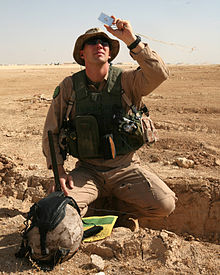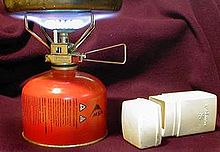Survival kit


A survival kit is a set of tools and supplies that helps a person survive in an emergency. Civil and military aircraft, lifeboats, and spacecraft are equipped with survival kits.
Usully, such kits contain tools to provide shelter against the elements, help them to keep warm, have a means to signal to rescuers and finding the way back to help. Such kits also contain food and water, for a short period of time. They also contain a first aid kit. Supplies in a survival kit normally include a knife (often a Swiss army knife or a multi-tool), matches, tinder, first aid kit, bandana, fish hooks, sewing kit, and a flashlight.
People who work in remote locations, or in those with extreme climates usually have a survival kit. Such people include forestry workers, surveyors, and bush pilots.
The American Red Cross recommends an emergency preparedness kit that is easy to carry and use in the event of an emergency or disaster.[1][2][3]


Typical contents[change | change source]
The Federal Emergency Management Agency (FEMA) is the United States's agency responsible for disaster planning and emergency resource management. It gives the following list for a three-day basic emergency supply kit.[4] Similar items can also be found from other national emergency response agencies.
The suggested contents of a bug-out bag vary and can also include weapons for defense from dangerous animals or people.[5]
- Water (one gallon per person per day for at least three days, for drinking and sanitation)
- Food (at least a three-day supply of non-perishable food)
- Battery-powered or hand crank radio and a NOAA Weather Radio with tone alert
- Flashlight
- First aid kit
- Extra batteries
- Whistle (to signal for help)
- Dust mask (to help filter contaminated air)
- Plastic sheeting and duct tape (to shelter in place)
- Wet wipes, garbage bags and plastic ties (for personal sanitation)
- Wrench or pliers (to turn off utilities)
- Manual can opener (for food)
- Local maps
- Cell phone with chargers and a backup battery
References[change | change source]
- ↑ "Be Red Cross Ready - Get a kit. Make a plan. Be informed". Redcross.org. Archived from the original on 2011-11-18. Retrieved 2011-11-26.
- ↑ "Be Red Cross Ready - Get a kit. Make a plan. Be informed" (PDF). Redcross.org. Retrieved 2021-09-26.
- ↑ "Survival Kit Supplies". Redcross.org. Retrieved 2021-09-26.
- ↑ "How to Build a Kit for Emergencies | FEMA.gov". www.fema.gov. Retrieved 25 August 2021.
- ↑ South, J. Allan (1990). "Chapter 11 (Equipment), Bug-Out Bag Contents". The Sense of Survival. Orem, Utah: Timpanogos Publishers. p. 221. ISBN 0-935329-00-5.
